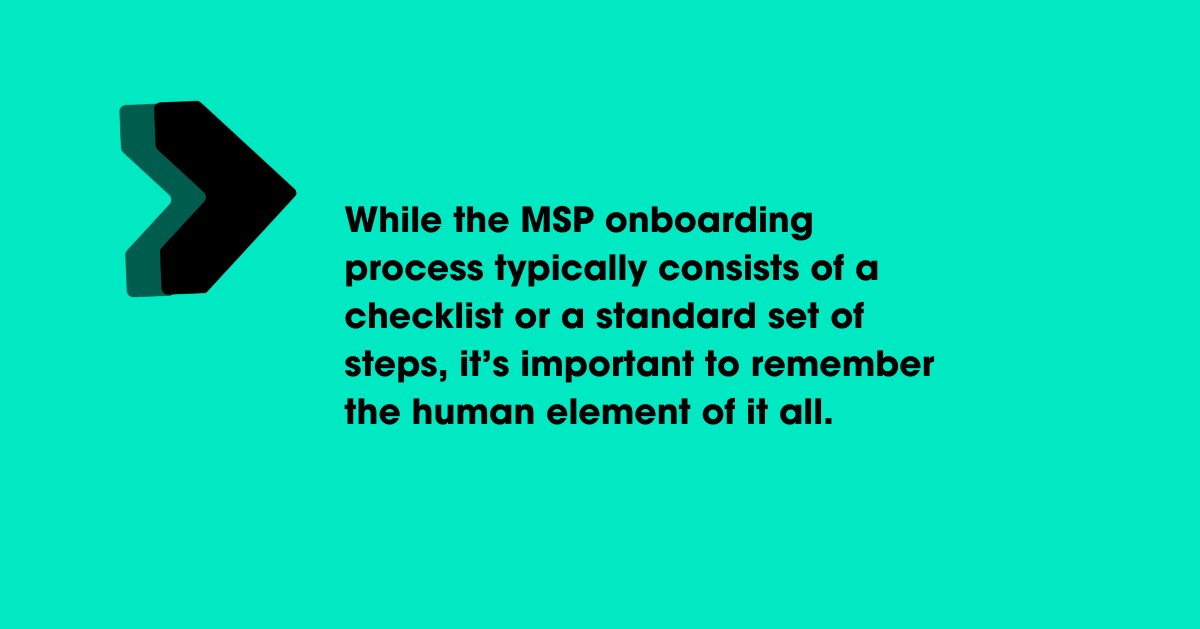If there were a single word to define the MSP onboarding process in 2020, it would be ‘trust.’
Trust all around – the client, the project vendor, and the managed service provider – along with an implicit understanding that all involved parties are responsible for ensuring its overall success. For the client, there’s that excitement of getting to play with a new IT system or environment; for the project team, there might be the relief that comes with the “end” of the project. But it’s the MSP that needs to lay out the onboarding best practices for managed IT services that are effective, efficient, and achievable in a timely fashion.
The onboarding process encompasses all the processes through which the project vendor (or a prior MSP), the MSP, and the client, work collaboratively to ensure a seamless transition from the project phase to the support and maintenance phase.
Here are four MSP onboarding tips that can help contribute to sustainable success.
If you fail to plan…
This is a no-brainer – the critical elements of onboarding orbit around planning.
As an MSP, you are taking over the responsibility of essential production systems highly valued by your clients. It’s vital that your processes take into consideration all elements for a smooth knowledge transfer with the client and previous vendor. Done effectively and thoroughly, this could take anywhere between 2 to 4 weeks. The onboarding process, according to Harry Marsland, General Manager of Global Managed Services at Appnovation, has all parties collaboratively build and execute a plan for the transition of management responsibility for the in-scope systems to the new MSP. The goal of the transition is that the new MSP and client are aligned on expectations and that the MSP is equipped to manage the systems in accordance with those expectations. For Appnovation, the onboarding process supports our goal of maximizing the value and protecting the integrity of our clients’ production systems.
All parties will have an eye on building out service expectations that are beyond what’s in the contract. For example, this could involve establishing a level of client awareness and comfort in utilizing the MSP ticketing system and reporting processes.
Remember that one size doesn’t fit all

The process needs to account for the uniqueness of the client and people involved, in addition to the system complexity, SEO audits, architecture assessment, and other technical requirements. “Clients are human; it’s a process of humans interacting with humans. And they might want to do things a certain way. As a full-service digital consulting business, Appnovation has leading capabilities and experience throughout the technology stack. An issue impacting Drupal, for example, we may have seen a thousand times – But for our clients, it might be something they’re encountering for the first time. We are always mindful of that,” says Marsland. Keeping our clients’ customers at the center of all considerations, we leverage our expertise in digital experience to forge strong relationships with clients and deliver drastic and sustainable improvements in customer experience. Recognizing this when customizing an onboarding roadmap is a game-changer.
Don’t see the forest for the trees
For a project team, closing a project on schedule and within budget is a crucial metric for success. The maintenance of the digital asset post-launch sometimes falls off the list of priorities.
For an MSP, and by extension, the client, the opposite is true – successful deployment and maintenance post-launch is the ultimate performance indicator. A clear understanding of the “why” and “what” of the build is crucial for this. Ensuring an effective transition requires someone from the MSP team to work alongside the project team. “The client expects and wants the new system to work reliably and predictably, and to deliver the expected business value, in production. The project vendor and MSP need to have that as central to how the project’s success is measured. It's about ensuring that the client can experience comfort and value in operating their new system or environment,” says Marsland.
Set the stage to deliver value
Understandably, the project team members are trained to be laser-focused on budget, schedule, and immediate deliverables while progressing the project. However, to successfully build a knowledge-based production solution for long-term success, open communication between project vendor, client, and MSP is essential.
Documentation is critical to the implementation process; the project delivery and MSP teams must collaborate, assess, and evaluate system architecture, specifications, and advanced security protocols – virtually everything associated with the build itself.
“There will be bumps in the night, and solutions will always need incident management. But if there's an extraordinary number of incidents or bugs that the MSP needs to resolve, the onboarding has not gone that well. Defining success for an MSP onboarding is a measurement of comfort and service quality within the first three months," says Marsland.
For an MSP, onboarding is business as usual. But for a client, it’s the consistent availability of a reliable stack of digital assets that support business-critical outcomes like user experience. At Appnovation, we understand that. Our clients around the globe in various industries leverage our integrated digital strategy and managed services capabilities to deliver meaningful experiences that build lasting relationships with their customers.


